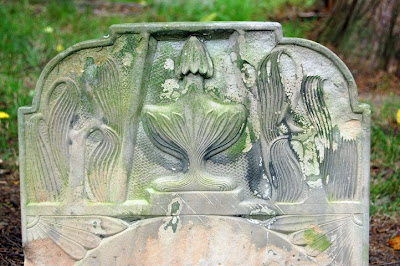Ali has figured out that she's descended from one of the first families to settle in Hancock County. The McKinnis family came to Ohio from Scotland and claimed the area where Litzenberg Woods is today. In fact, the McKinnis Homestead at the park is part of her family history.
That's a pretty well-known park in the district. What is less well-known is that there is a cemetery near there, where most of the McKinnis clan is buried. It's called Indian Green and was the first cemetery in Hancock County. Years later, after Maple Grove was established, families were told to remove their dead from Indian Green. Most did, but the McKinnis' did not.
Sunday afternoon we discovered Indian Green.

It's quite beautiful, tucked away near the banks of the Blanchard River. Rather than being depressing, a cemetery that old is kind of peaceful. There are no "new" graves. Just lots of weathered sandstone monuments to people dead for more than a hundred years.
Some of the markers are more art than just memorial.



As we wandered the grounds, slowing looking at each of the 107 remaining plots there was one thing that we were puzzled about. All over the cemetery were sticks with feathers and a red pouch sticking out of the ground.

We knew it had something to do with Native American people. After we found this on ancestry.com it made much more sense.
"When the first settlers came into Liberty Township they found a tract of cleared land, covering about twelve acres, on the north bank of the Blanchard in Section 7, some of which had apparently been under cultivation, and was called by the pioneers "Indian Green." An Indian graveyard was located here, and also an orchard of plum trees, which supplied the neighbors with that fruit. Several pioneers have stated it was the general impression among the first settlers that an Indian village once flourished at this point. The Ottawas had two villages still farther down the river, in what is now Putnam County, and it is believed the Wyandots had a settlement at Indian Green, whence they were removed, in 1818, to Big Spring Reservation. It is a well attested fact that the Indians occasionally visited the old burying-ground, and guarded the remains of their ancestors buried here with jealous care. Mr. Poe says his father told him that a pioneer named Ellison settled with his family on this tract at an early day, and after building a cabin began the work of opening the graves for the purpose of obtaining the valuables supposed to be buried with the Indian dead. The Indians soon heard of this desecration, and at once visited Ellison, and so thoroughly frightened him by threats of retaliation that he deserted his cabin and "silently stole away." The wagon road along the north bank of the river passes through this old Indian cemetery, no trace of which now remains."
Notice the wording – "whence they were "removed" in 1818 to Big Spring Reservation." I did a little more research on my Ohio history and the move to Big Spring didn't last long. According to "Ohio History: The Scholarly Journal of the Ohio Historical Society," the sixteen thousand acre tract at Big Spring became the subject of the Treaty of January 19, 1832, negotiated at McCutcheonsville [McCutchenville], Ohio, by which the Wyandot did "forever cede and relinquish to the United States the reservation." The prologue asserted that the Wyandot were "fully convinced" they could not prosper and be happy "in their present situation in . . . Ohio, in the vicinity of a white population, which is continually increasing and crowding around them." Besides, "the morals of many of their people will be daily becoming more and more vitiated." This was an outright sale to the United States. This band of Wyandot were to remove to Canada or the Huron River region of Michigan, "or to any place they may obtain a right or privilege from other Indians to go."
I learned a lot from a short afternoon at a cemetery. And not all of it makes me proud.
2 comments:
Those red pouches are called "prayer ties." They are sacred and meant for protection of the people buried there.
www.aaanativearts.com
THANK YOU so much for the explanation. We knew that it was something sacred and we felt very honored to see them. What we kept thinking as we walked the cemetery was that there were all these big, expensive markers for the "settlers" but the real settlers were nameless. It made us sad.
Post a Comment